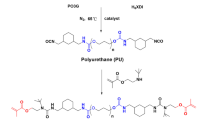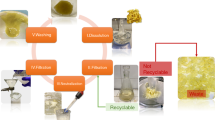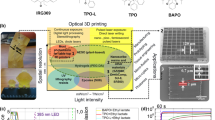Abstract
The exploitation of plant-based monomers for additive manufacturing is a very promising approach to reduce the usage of petroleum-based plastics. In vat photopolymerization, acrylate epoxidized soybean oil (AESO) stands out as a versatile photocurable resin that can be modified and combined with other materials for multiple applications. In this work, different ratios of AESO were combined with isobornyl methacrylate (IBOMA), to develop a resin that exhibits similar mechanical properties to standard fossil-based resins. The photopolymerization reaction and conversion rate was monitored using FT-IR analysis, which showed conversions above 80%. Furthermore, curing tests revealed that the biobased resin needed less energy to cure when compared to commercial resins. The parts fabricated using the biobased resin also demonstrated enhanced tensile strength, tunable elongation at break and swelling resistance, which were comparable to standard fossil-based resins. This work demonstrates the potential of the proposed systems as a valuable alternative to traditional resins, paving the way for the development of high-performance materials for stereolithographic applications.






Similar content being viewed by others
Data and code availability
Not Applicable.
References
Sheldon RA, Norton M (2020) Green chemistry and the plastic pollution challenge: towards a circular economy. Green Chem 22:6310–6322. https://doi.org/10.1039/D0GC02630A
Bioplastic E (2022) Bioplastics market data. https://www.european-bioplastics.org/market/#. Accessed 11 Nov 2022
Voet VSD, Guit J, Loos K (2021) Sustainable Photopolymers in 3D Printing: A Review on Biobased, Biodegradable, and Recyclable Alternatives. Macromol Rapid Commun 42:2000475. https://doi.org/10.1002/marc.202000475
Bassett AW, Honnig AE, Breyta CM et al (2020) Vanillin-Based Resin for Additive Manufacturing. ACS Sustain Chem Eng 8:5626–5635. https://doi.org/10.1021/acssuschemeng.0c00159
Branciforti DS, Lazzaroni S, Milanese C et al (2019) Visible light 3D printing with epoxidized vegetable oils. Addit Manuf 25:317–324. https://doi.org/10.1016/j.addma.2018.11.020
Sutton JT, Rajan K, Harper DP, Chmely SC (2018) Lignin-Containing Photoactive Resins for 3D Printing by Stereolithography. ACS Appl Mater Interfaces 10:36456–36463. https://doi.org/10.1021/acsami.8b13031
Maturi M, Pulignani C, Locatelli E et al (2020) Phosphorescent bio-based resin for digital light processing (DLP) 3D-printing. Green Chem 22:6212–6224. https://doi.org/10.1039/D0GC01983F
Guit J, Tavares MBL, Hul J et al (2020) Photopolymer Resins with Biobased Methacrylates Based on Soybean Oil for Stereolithography. ACS Appl Polym Mater 2:949–957. https://doi.org/10.1021/acsapm.9b01143
Lebedevaite M, Talacka V, Ostrauskaite J (2021) High biorenewable content acrylate photocurable resins for DLP 3D printing. J Appl Polym Sci 138:50233. https://doi.org/10.1002/app.50233
Cui Y, Yang J, Lei D, Su J (2020) 3D Printing of a Dual-Curing Resin with Cationic Curable Vegetable Oil. Ind Eng Chem Res 59:11381–11388. https://doi.org/10.1021/acs.iecr.0c01507
Skliutas E, Lebedevaite M, Kasetaite S et al (2020) A Bio-Based Resin for a Multi-Scale Optical 3D Printing. Sci Rep 10:9758. https://doi.org/10.1038/s41598-020-66618-1
Bennett J (2017) Measuring UV curing parameters of commercial photopolymers used in additive manufacturing. Addit Manuf 18:203–212. https://doi.org/10.1016/j.addma.2017.10.009
Bártolo PJ (2011) Stereolithography. Springer, US, Boston, MA
Zakeri S, Vippola M, Levänen E (2020) A comprehensive review of the photopolymerization of ceramic resins used in stereolithography. Addit Manuf 35:101177. https://doi.org/10.1016/j.addma.2020.101177
Palucci Rosa R, Rosace G, Arrigo R, Malucelli G (2022) Preparation and Characterization of 3D-Printed Biobased Composites Containing Micro- or Nanocrystalline Cellulose. Polymers (Basel) 14:1886. https://doi.org/10.3390/polym14091886
Tathe DS, Jagtap RN (2015) Biobased reactive diluent for UV-curable urethane acrylate oligomers for wood coating. J Coatings Technol Res 12:187–196. https://doi.org/10.1007/s11998-014-9616-5
Barkane A, Platnieks O, Jurinovs M, Gaidukovs S (2020) Thermal stability of UV-cured vegetable oil epoxidized acrylate-based polymer system for 3D printing application. Polym Degrad Stab 181:109347. https://doi.org/10.1016/j.polymdegradstab.2020.109347
Kunwong D, Sumanochitraporn N, Kaewpirom S (2011) Curing behavior of a UV-curable coating based on urethane acrylate oligomer: The influence of reactive monomers. Songklanakarin J Sci Technol 33:201–207
Pelletier H, Belgacem N, Gandini A (2006) Acrylated vegetable oils as photocrosslinkable materials. J Appl Polym Sci 99:3218–3221. https://doi.org/10.1002/app.22322
Yang Z, Peng H, Wang W, Liu T (2010) Crystallization behavior of poly(ε-caprolactone)/layered double hydroxide nanocomposites. J Appl Polym Sci 116:2658–2667. https://doi.org/10.1002/app
Salih AM, Bin AM, Ibrahim NA et al (2015) Synthesis of radiation curable palm oil-based epoxy acrylate: NMR and FTIR spectroscopic investigations. Molecules 20:14191–14211. https://doi.org/10.3390/molecules200814191
Yang X, Li S, Xia J et al (2015) Renewable Myrcene-based UV-curable Monomer and its Copolymers with Acrylated Epoxidized Soybean Oil: Design, Preparation, and Characterization. BioResources 10:. https://doi.org/10.15376/biores.10.2.2130-2142
Cingesar IK, Marković M-P, Vrsaljko D (2022) Effect of post-processing conditions on polyacrylate materials used in stereolithography. Addit Manuf 55:102813. https://doi.org/10.1016/j.addma.2022.102813
Menard KP (2008) Dynamic Mechanical Analysis. CRC Press
Ligon-Auer SC, Schwentenwein M, Gorsche C et al (2016) Toughening of photo-curable polymer networks: A review. Polym Chem 7:257–286. https://doi.org/10.1039/c5py01631b
Britannica TE of E (2022) Young’s modulus. In: Encycl. Br. https://www.britannica.com/science/Youngs-modulus. Accessed 9 Nov 2022
Jin F-L, Park S-J (2008) Impact-strength improvement of epoxy resins reinforced with a biodegradable polymer. Mater Sci Eng A 478:402–405. https://doi.org/10.1016/j.msea.2007.05.053
Dijkstra P, Tietema M, Folkersma R et al (2018) Biobased Acrylate Photocurable Resin Formulation for Stereolithography 3D Printing. ACS Omega 3:1403–1408. https://doi.org/10.1021/acsomega.7b01648
Anseth KS, Goodner MD, Reil MA et al (1996) The Influence of Comonomer Composition on Dimethacrylate Resin Properties for Dental Composites. J Dent Res 75:1607–1612. https://doi.org/10.1177/00220345960750081301
Rosace G, Palucci Rosa R, Arrigo R, Malucelli G (2021) Photosensitive acrylates containing bio-based epoxy-acrylate soybean oil for 3D printing application. J Appl Polym Sci 138:51292. https://doi.org/10.1002/app.51292
Li Y, Mao Q, Yin J et al (2021) Theoretical prediction and experimental validation of the digital light processing (DLP) working curve for photocurable materials. Addit Manuf 37:101716. https://doi.org/10.1016/j.addma.2020.101716
Author information
Authors and Affiliations
Corresponding author
Ethics declarations
Ethical approval
Not Applicable.
Conflicts of interest
The author(s) declare that they have no known competing financial interests or personal relationships that could have appeared to influence the work reported in this paper.
Additional information
Publisher's Note
Springer Nature remains neutral with regard to jurisdictional claims in published maps and institutional affiliations.
Supplementary Information
Below is the link to the electronic supplementary material.
Rights and permissions
Springer Nature or its licensor (e.g. a society or other partner) holds exclusive rights to this article under a publishing agreement with the author(s) or other rightsholder(s); author self-archiving of the accepted manuscript version of this article is solely governed by the terms of such publishing agreement and applicable law.
About this article
Cite this article
Rosa, R.P., Rosace, G., Arrigo, R. et al. Preparation and characterization of a fully biobased resin system for 3d-printing, suitable for replacing fossil-based acrylates. J Polym Res 30, 139 (2023). https://doi.org/10.1007/s10965-023-03523-x
Received:
Accepted:
Published:
DOI: https://doi.org/10.1007/s10965-023-03523-x




